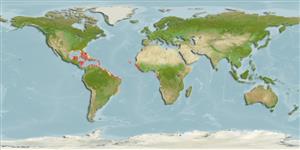Environment: milieu / climate zone / depth range / distribution range
Sinh thái học
Biển Cùng sống ở rạn san hô; Mức độ sâu 1 - 26 m (Ref. 89885), usually 1 - 2 m (Ref. 89885). Tropical
Western Atlantic: Eastern Atlantic and Brazilian populations need further investigation, (including morphological and genetic), to determine if they represent R. subbifrenatus or undescribed species (Ref. 89885).
Bộ gần gũi / Khối lượng (Trọng lượng) / Age
Maturity: Lm ? range ? - ? cm
Max length : 18.0 cm TL con đực/không giới tính; (Ref. 7251)
Các tia vây lưng cứng (tổng cộng) : 3 - 4; Các vây lưng mềm (tổng cộng) : 21 - 25; Tia cứng vây hậu môn: 1; Tia mềm vây hậu môn: 11 - 13. This species is distinguished from its congeners by the following set of characters: pectoral fin and distal portions of soft dorsal, caudal, and anal fins are tan to brown in life and when preserved; numerous dark spots on head and trunk; spots on head posterior to horizontal through center of orbit usually prominent, round or oblong, and one or more usually equal in size to or larger than diameter of pupil; posterior portion of interorbital region usually with 2 pairs of spots (sometimes joined as a stripe), spots directly on or abutting orbital rim; belly and caudal fin usually without spots; D III or IV (nearly bimodal), total dorsal-fin elements modally 26; pectoral fin rays modally 16; total caudal-fin rays modally 25; lower jaw extending anteriorly beyond upper jaw, mean difference between distance from tip of lower jaw to orbit and tip of upper jaw to orbit 4% HL; caudal peduncle relatively wide, average depth 13% SL (Ref. 89885).
Inhabits clear tropical waters to depths of 26 m, but it is found most commonly at 1-2 m (mean maximum depth of specimens collected is 5 m, only 6 were captured deeper than 15 m). Lives in tide pools, among coral rubble, in patch reefs and shallow spur and groove reef areas, occasionally found on steep vertical walls (Ref. 89885). A solitary species (Ref. 26340). Adults are said to prefer clearer waters than juveniles (Ref. 7320).
Life cycle and mating behavior
Maturities | Sự tái sinh sản | Spawnings | Egg(s) | Fecundities | Ấu trùng
Maugé, L.A., 1990. Grammistidae. p. 709-710. In J.C. Quero, J.C. Hureau, C. Karrer, A. Post and L. Saldanha (eds.) Check-list of the fishes of the eastern tropical Atlantic (CLOFETA). JNICT, Lisbon; SEI, Paris; and UNESCO, Paris. Vol. 2. (Ref. 7320)
IUCN Red List Status (Ref. 130435)
Threat to humans
Harmless
Human uses
Các nghề cá: Tính thương mại
Các công cụ
Special reports
Download XML
Các nguồn internet
Estimates based on models
Preferred temperature (Ref.
123201): 25.5 - 28.1, mean 27.4 °C (based on 888 cells).
Phylogenetic diversity index (Ref.
82804): PD
50 = 0.5010 [Uniqueness, from 0.5 = low to 2.0 = high].
Bayesian length-weight: a=0.01148 (0.00451 - 0.02922), b=3.06 (2.84 - 3.28), in cm total length, based on LWR estimates for this (Sub)family-body shape (Ref.
93245).
Mức dinh dưỡng (Ref.
69278): 3.8 ±0.7 se; based on size and trophs of closest relatives
Fishing Vulnerability (Ref.
59153): Low vulnerability (10 of 100).
Nutrients (Ref.
124155): Calcium = 71.5 [39.3, 138.8] mg/100g; Iron = 0.645 [0.335, 1.129] mg/100g; Protein = 18.6 [16.8, 20.3] %; Omega3 = 0.167 [0.105, 0.265] g/100g; Selenium = 23.3 [13.0, 44.2] μg/100g; VitaminA = 142 [46, 462] μg/100g; Zinc = 1.32 [0.89, 1.93] mg/100g (wet weight);
